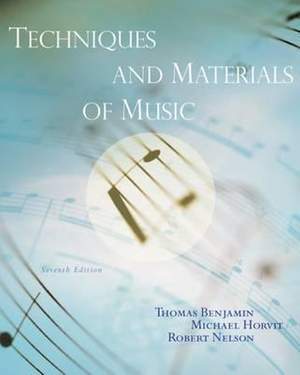
Techniques and Materials of Music: From the Common Practice Period Through the Twentieth Century
- Author: Benjamin, Thomas
- Author: Horvit, Michael
- Author: Nelson, Robert
Book
$87.25Out of stock at the UK distributor
Contents
- Part I : RUDIMENTS.
- 1. The Great Staff and Piano Keyboard.
- 2. Accidentals.
- 3. Intervals.
- 4. Major and Minor Scales.
- 5. Key Signatures.
- 6. Triads.
- 7. Meter and Rhythm.
- Part II : DIATONIC MATERIALS.
- 1. Triads in Root Position.
- 2. The Tonic Triad in Root Position.
- 3. Connection of Tonic and Dominant Triads in Root Position.
- 4. The Dominant Seventh Chord in Root Position.
- 5. Connection of Tonic and Subdominant Triads in Root Position.
- 6. Connection of Subdominant and Dominant Triads in Root Position.
- 7. Cadences Employing the Tonic, Subdominant, and Dominant Triads in Root Position.
- 8. The Cadential Tonic Six-Four Chord.
- 9. Tonic, Subdominant, and Dominant Triads in First Inversion.
- 10. The Supertonic Triad.
- 11. Inversions of the Dominant Seventh Chord.
- 12. Linear (Embellishing) Six-Four and Other Chords.
- 13. Submediant and Mediant Triads in Root Position and First Inversion.
- 14. The Leading Tone Triad.
- 15. Variant Qualities of Triads.
- 16. The Sequence.
- 17. The Supertonic Seventh Chord.
- 18. The Leading Tone Seventh Chord.
- 19. Other Diatonic Seventh Chords.
- Part III : CHROMATIC MATERIALS.
- 1. Secondary (Applied, Borrowed) Dominants.
- 2. Modulation.
- 3. Linear (Embellishing) Diminished Seventh Chords.
- 4. The Neapolitan Triad.
- 5. Augmented Sixth Chords.
- 6. Modulation by Other Means.
- 7. Ninth Chords.
- Part IV : TWENTIETH-CENTURY MATERIALS.
- 1. Twentieth-Century Techniques: General Comments.
- 2. Further Concepts for Analysis.
- 3. Rhythmic and Metric Devices.
- 4. Tertian Harmony.
- 5. The Diatonic (Church) Modes.
- 6. Pandiatonicism.
- 7. Exotic (Artificial, Synthetic) Scales.
- 8. Quartal and Secondal Harmony.
- 9. Polyharmony and Polytonality.
- 10. Free Atonality.
- 11. Twelve-Tone Serialism.
- 12. Additional Contemporary Procedures.
- Part V : REFERENCE MATERIALS.
- 1. Musical Calligraphy.
- 2. The Harmonic Series.
- 3. Nonharmonic (Nonchord) Tones.
- 4. Relative and Linear Motion.
- 5. Guidelines for Voice Leading in Strict Four-Part Writing.
- 6. Guidelines for Doubling in Strict Four-Part Writing.
- 7. Checklist for Part Writing.
- 8. Chord Functions in Tonal Music.
- 9. Figured-Bass Symbols.
- 10. Procedure for Harmonizing a Figured Bass.
- 11. Procedure for Harmonizing a Melody.
- 12. Models for Expansion and Elaboration.
- 13. Cadence and Phrase Structure.
- 14. Typical Phrase Variants.
- 15. The Motive.
- 16. The Sequence.
- 17. Textures.
- 18. an introduction to Tonal Melody.
- 19. an introduction to Tonal Counterpoint.
- 20. Form.
- 21. Checklist for Analysis.
- 22. Composition Checklist.
- 23. Instrumental Ranges and Transpositions. Bibliography. Index.


